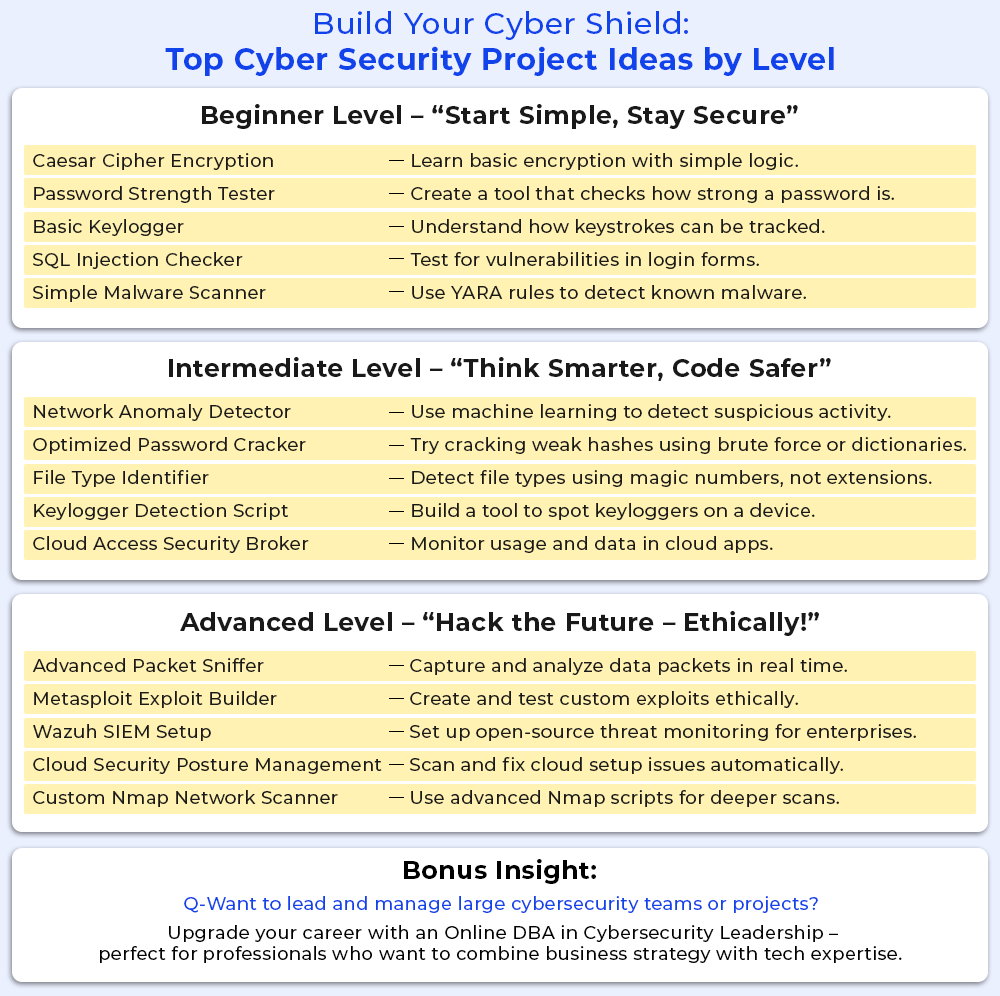Expert Interviews
- University Reviews
- Career Guide
 Video Counseling
Video CounselingImportant Facts
- Ask any Question - CV Forum

Top Cyber Security Project Ideas for Students and Professionals
Kopal Srivastava Jul 28, 2025 1.1K Reads

Cybersecurity refers to the utilization of tools, systems, and measures for safeguarding computers, networks, and information against unauthorized access or damage by hackers, viruses, or other malicious threats. Cybersecurity prevents individuals from stealing data or from causing harm to systems. Cybersecurity also ensures that personal, corporate, and government information remains safeguarded against misuse.
The primary objective of cybersecurity is to ensure critical information remains secure and confidential. It also safeguards systems from being interrupted by cyberattacks or even natural disasters.
Why a Career in Cybersecurity?
Cybersecurity is among the most sought-after professions in the contemporary world. The following are some easy explanations as to why it's an ideal career choice:
-
Plenty of Career Opportunities
Cybersecurity is growing fast because of the amplifying threats in the digital space. This means that there are numerous job opportunities. If you keep learning and stay updated, you will have plenty of opportunities for career growth. Analyst, manager, chief security officer-there are numerous rungs to climb.
-
Big Money
Cybersecurity jobs usually pay well. Since the job is so critical, employers are willing to pay top dollar to the right candidate. Besides that, your earnings can increase swiftly with an increase in time and its acquisition.
-
Monotonous Work?
The world of cybersecurity has all the time kept on evolving. Evolution is there for hackers and threats; so is evolution for means and methods to curb them. You are forever learning something new, and your work will never feel repetitive or dull.
-
Job Satisfaction
Difficult but fulfilling is cybersecurity work. You solve real-world problems and help to protect valuable data and systems. That gives you purpose and motivates you to learn.
Cybersecurity isn't a career—it's a calling, one of discovery, advancement, and influence. With proper training, such as the Advanced Executive Program in Cybersecurity, you can join this dynamic field and construct a sound, secure future.
Where Cybersecurity Is Applied (Use Cases)
Cybersecurity aids in securing individuals, businesses, and networks against numerous forms of cyberattacks such as viruses, ransomware, phishing, data theft, hacking, and denial-of-service (DoS) attacks. Some of the ways cybersecurity is applied include:
-
Static Response to Cyberattacks
A cyberattack in full progress must be dealt with immediately. Cybersecurity services could assist a business in detecting the attack and in its prevention and damage repair in elapse time. This is considered incident response and management.
-
Protection of Business and Personal Information
It is through this ministry of cybersecurity that this crucial information is kept safe. It prevents hackers from stealing personal information, business secrets, or government documents. It prevents such things as identity theft or loss of valuable services.
-
Securing Online Payment Systems
Cybersecurity in a company, if implemented by measures such as antiviruses, firewalls, and network security, will safeguard online payments and related customer information. So there would be a lesser chance of getting hacked.
-
Establishing Trust Between a Company and Customer
Companies garner trust from their customers when the people know their money and information are ensured. Good cybersecurity creates a feeling of security, and the customers feel free in using a company's service.
-
Identifying System Weaknesses
Cybersecurity can search whether a system is vulnerable to breaches. It uses techniques such as vulnerability audits, firewall log analysis, and tests and correct vulnerabilities before hackers have a chance to exploit them.
Briefly, cybersecurity is applied in numerous ways to safeguard data, systems, money, and trust. It enables companies to remain safe and resilient in the cyber world.Build Your Cyber Shield: Top Cyber

Cyber Security Projects for College Students
If you’re a college student interested in cybersecurity, here are some fun and useful project ideas you can try. These projects will help you learn and practice real-world skills.
- Test Password Strength
This project is about building a tool that checks how strong a password is.
It will look at things like:
- How long is the password?
- If it has numbers, capital letters, and special characters
- If it’s easy to guess
The tool will give tips to make passwords stronger. You can make it as a simple website or desktop app. This project helps people create better, safer passwords and understand why strong passwords are important.
-
Integrity Checker
This project is about checking if your system files are safe.
It will:
- Scan system files regularly
- Compare them to the original versions (using special codes called “hashes”)
- Alert you if any file has been changed without permission
This project helps keep computers safe from hidden changes or hacks.
- Simple Malware Scanner Using Yara
This project uses a tool called Yara to find malware (bad software).
It will:
- Scan files and folders
- Look for known patterns used in malware
- Show a report if any dangerous file is found
This is a great way to learn how antivirus tools work and how threats are found using rule-based systems.
- Bug Bounties and Hackathons
You can also try finding bugs on real websites! Many companies have bug bounty programs. If you find a problem, they might pay you for it.
You can:
- Look for small issues or weak spots on websites
- Report them to the company
- Get rewards if your report is useful
Also, join cybersecurity hackathons. These are events where people work in teams to solve security problems. You’ll learn from experts and work with other students, designers, and developers.
The more bugs you find, the higher your rank in bug bounty platforms. This is a great way to:
- Learn ethical hacking
- Build your profile
- Earn some money
- Start your career in cybersecurity
These projects are perfect for learning, practicing, and building your resume in the field of cybersecurity.
Cyber Security Final Year Projects
- Hashed Password Cracker
- Source: arstechnica
This project is about creating a tool that can try to guess or "crack" passwords that are saved in a special coded form called a hash.
The tool will use different methods, like:
- Brute force (trying every possible password),
- Dictionary attack (using a list of common passwords),
- Rainbow tables (pre-made lists of hash values and their original passwords).
The tool will have a simple screen where users can enter the hash. It will work fast by using smart techniques to save time.
Goal: Help users get back lost passwords or check how strong their password protection really is.
- Simple Vulnerability Matcher
- Source: vuls
This project is about making a tool that checks software or computer systems for known security problems (called vulnerabilities).
It works by:
- Scanning the software or system,
- Comparing it with a list of known problems from a database,
- Finding matches and showing which ones are risky.
It will give users a clear report and suggest how to fix the problems.
- Goal: Help people find and fix security issues in their software easily.
- Simple Web Vulnerability Scanner
- Source: Acunetix
This tool will look for security problems in websites or web apps. It will do this by:
- Visiting different parts of the website (crawling),
- Running tests automatically (scanning),
- Trying to break it using special inputs (fuzzing).
It will look for common web issues like:
- XSS (Cross-Site Scripting) – putting harmful code into websites,
- SQL Injection – stealing or messing with data from the website's database,
- IDOR (Insecure Direct Object Reference) – accessing data you shouldn’t see.
After scanning, it will show a report with all the problems found and how to fix them.
- Goal: Make it easier to find and fix website security issues.
Cyber Security Projects for Beginners
- Caesar Cipher Encryption/Decryption
- Caesar Cipher is one of the oldest ways to hide messages. Julius Caesar used it to send secret messages to his friends.
- This method uses a number key to change the position of letters in a message. For example, with key “3”, the word “SECURITY” becomes “VHFXULWB” by shifting each letter three steps forward.
- You can build this project using any programming language that can encrypt and decrypt text. It’s a good beginner project to learn how encryption works.
- Simple Non-Hashed Password Cracker
This tool tries to find weak or simple passwords that are saved in plain text or weak formats.
It uses tricks like brute force, dictionary attack, and pattern matching to guess the real password. You can upload a password file, and the tool will try to crack it. This project helps you understand how attackers guess passwords and how to protect them.
- Simple Network Scanner
A network scanner helps check your Wi-Fi or internet network. It finds connected devices, open ports, and running services.
This project will let you scan a group of IP addresses or a single address. It uses scanning methods like ICMP, TCP, and UDP to find information. It’s a good tool to check if your network has weak spots or open doors for attackers.
- DoS Attack Detection Tool
A DoS (Denial of Service) attack floods your network with too much traffic to crash it.
This beginner-friendly tool will help detect such attacks. It watches the traffic, looks for sudden spikes, and alerts you if it sees something wrong. It tells you when an attack may be happening, so you can stop it quickly.
- SQL Injection Checker
SQL Injection is a hacking method where attackers put harmful code in login or search boxes to access data.
Your project can create a tool that checks if a website or app is weak against such attacks. If it finds any issues, the tool can give tips to fix them. This project teaches you how web apps can be attacked and how to protect them.
Pro Tip for Cybersecurity Professionals
Want to climb the leadership ladder in cybersecurity? Combine your tech skills with business mastery. Pursue an Online DBA in Cybersecurity or Tech Management and learn how to turn your project experience into boardroom-level strategy.
Cyber Security Projects for Intermediate Learners
-
Optimized Password Cracker
This project is about creating a fast and smart tool to break encrypted passwords. It will work on passwords protected by hashing methods like MD5, SHA-1, and bcrypt.
It will use powerful systems like GPUs (graphics cards) and smart coding to work faster. You can also set it to try passwords in different ways—like using a list of common passwords or trying all possible combinations. This tool helps find lost passwords or test how strong your passwords are.
- Network Anomaly Detection Using Machine Learning
This tool will help keep networks safe using machine learning. It will study internet traffic to find strange or unusual behavior, which may mean there’s a security problem.
The system will learn what normal traffic looks like and alert you if anything strange happens. It helps in stopping attacks before they become serious. A great project if you want to learn machine learning in cybersecurity.
- File Type Checker Using Magic Numbers
Sometimes, file extensions like .jpg or .pdf are wrong or missing. This tool looks inside the file to check what type it really is using something called a “magic number”—a special code at the beginning of a file.
The project will use a list of these magic numbers to find the real file type. This helps in managing unknown files and recovering lost data. You can even build features to find files with mixed content or hidden files.
- Keylogging (Spyware)
A keylogger is a type of spyware that records what someone types on their keyboard. This project is about creating such a tool. You can try:
- Building a script that saves every key pressed
- Hiding the tool inside a regular-looking app
- Making another script that can detect keyloggers on a computer
This project is helpful if you’re learning offensive security or ethical hacking (how hackers think).
- Cloud Access Security Broker (CASB)
Many companies use cloud apps like Google Drive or Zoom. A CASB helps the company watch what’s happening in those apps and keep their data safe.
In this project, you can:
- Check which apps your company uses in the cloud
- Find out if important data is being shared safely
- Suggest better ways to protect cloud information
This project teaches how to protect data in cloud-based systems.
- Lost Data Recovery Tool
Sometimes, a virus or ransomware can delete or lock your files. This project is about making a tool that can help get that data back.
You will learn:
- How to recover data from backups
- How to use recovery software for damaged or locked files
- How to create a plan to save important files from future attacks
This is a very helpful project for anyone interested in information security or disaster recovery.
These intermediate-level projects will help you understand how to defend, detect, and sometimes even think like a hacker. Great practice for careers in ethical hacking, security analysis, or IT support.
Advanced Cyber Security Projects
- Advanced Network Scanner Using Nmap
This project uses Nmap, a popular tool for scanning networks. You’ll build a scanner that finds computers, open ports, services, and any weaknesses in a network.
Nmap has many scripts that can do powerful tasks. Your tool will use those scripts to give detailed reports about the network. This helps you find and fix security problems.
- Advanced Network Packet Capturing Tool
This tool helps watch and understand the data that moves across a network. You can see the real-time data (called packets), filter it, and check for any issues.
It supports many network types and lets you focus on certain traffic. You can even save and show the results. This helps network teams to troubleshoot and secure their networks.
- Exploit Development Using Metasploit
Metasploit is a tool used by ethical hackers to test for weak spots in systems.
In this project, you will learn how to create and use tools inside Metasploit. You can try different types of attacks like code execution or getting admin rights. This helps improve your skills in offensive cybersecurity.
- Packet Sniffing Tool
A packet is a small piece of data sent over a network. In this project, you’ll make a tool that watches where the packets go and what they carry.
You can use Python to create a simple program that tracks data movement. It can help detect unauthorized access or hacking attempts. This is a good project if you're learning about network safety.
- Wazuh Open Source SIEM Tool
Wazuh is a free security tool used by companies to detect threats and manage incidents.
It can:
- Watch for intrusions (unauthorized access)
- Check log files
- Monitor file changes
- Find weak points in systems
This project is best for people interested in defensive security. Wazuh also has a strong online community, which makes learning easy.
- Cloud Security Posture Management
Companies use the cloud to store data and run applications. This project helps protect those cloud systems.You’ll set rules for safe usage and create a tool that automatically checks and fixes problems. It is a smart project if you want to learn about securing cloud platforms like AWS, Azure, or Google Cloud.Cybersecurity is important to stop data theft and hacking. These advanced projects help you get hands-on practice and learn how to defend networks, systems, and data.By doing projects like these, you’ll become more skilled and have better chances of getting a good job in cybersecurity. Tools like Wazuh, Metasploit, and Nmap will also make your resume stronger.
Turning Projects into Business Strategy: Why a Tech Leader Needs Business Skills
While working on these exciting cybersecurity projects, it’s also important to think beyond just the tech. Cyber threats don’t just affect systems; they affect entire businesses.
That’s where an Online DBA comes in. It’s a professional doctorate that helps you understand how to turn technical cybersecurity knowledge into business decisions, risk strategies, and executive leadership plans. Whether you're managing data breaches, leading SOC teams, or advising boardrooms, an Online DBA prepares you to lead with both tech and business confidence without pausing your career.
What is an Online DBA?
An Online DBA (Doctor of Business Administration) is a degree that helps working professionals become top business leaders, without quitting their job. It teaches you how to solve real business problems using smart strategies and deep research. You can study from anywhere, anytime, because it’s 100% online. Whether you work in marketing, finance, tech, or even cybersecurity, an Online DBA helps you grow into a decision-maker, not just a doer. It’s not just about theory, it’s about turning your work experience into powerful ideas that create real change. In short, it’s a smart way to earn a doctorate and lead with confidence.
Various universities offer an Online DBA. Some of them are mentioned below:
|
Universities |
Fees |
|
INR 6,00,000 |
|
|
INR 8,14,000 |
|
|
INR 8,12,500 |
|
|
INR 8,14,000 |
|
|
INR 5,50,000 |
|
|
INR 7,50,000 |
|
|
INR 7,00,000 |
Conclusion
In summary, doing cybersecurity projects is a wonderful way of learning and developing in the area. As either a novice or an expert, the projects allow you to grasp real-world issues and how to address them. You can develop tools, test systems, and learn how to secure data and networks. The projects also make your resume powerful and demonstrate your ability to potential employers. If you wish to continue your learning, you may also pursue business and leadership through an Online DBA. Continue learning, continue constructing, and prepare yourself for a bright future in cybersecurity.
FAQs (Frequently Asked Questions)
There are different types of cybersecurity used to protect data and systems. The main types are:
- Network Security – Protects computer networks.
- Information Security – Keeps data safe from unauthorized access.
- Application Security – Secures apps and software.
- Cloud Security – Protects data stored online.
- Endpoint Security – Secures devices like phones, laptops, etc.
Yes, cyber security is a great career choice. Companies need more experts to protect their data. Jobs are growing fast, and there’s a high demand for skilled professionals.
IT security projects are activities that help keep information and systems safe from hackers. Examples include:
- Making antivirus software
- Setting up firewalls
- Using SIEM tools for tracking threats
- Finding system weaknesses with scanners
A keylogger is a tool that records every key you press on your keyboard. Hackers can use it to steal things like passwords and credit card numbers by tracking what you type.
Some good cybersecurity project ideas are:
- Text encryption tools
- Keylogger detector programs
- Facial login systems
- Security scanners
- Login authentication systems
- Hidden message tools (steganography)
Yes, cybersecurity will be in high demand in 2025. As more devices and online systems are used, the risk of hacking grows. Companies need experts to keep their data and networks safe.
Next-generation cybersecurity uses smart tools like AI (artificial intelligence) and machine learning to find and stop threats faster and more accurately than older methods.
XDR stands for Extended Detection and Response. It is a tool that collects data from your network, computers, cloud, and more to detect and stop cyberattacks quickly.
Steganography is a method of hiding data inside pictures, videos, or other files. It’s used to add extra protection along with encryption to keep information safe.

10 Years of Experience / Storyteller / Research-driven Writer
Loves to create story and narrating them through a Podcast
Every query is essential.
Our team of experts, or experienced individuals, will answer it within 24 hours.
Recommended for you
Tired of dealing with call centers!
Get a professional advisor for Career!
LIFETIME FREE
Rs.1499(Exclusive offer for today)

Pooja
MBA 7 yrs exp

Sarthak
M.Com 4 yrs exp

Kapil Gupta
MCA 5 yrs exp
or



Career Finder
(Career Suitability Test)
Explore and Find out your Most Suitable Career Path. Get Started with our Career Finder Tool Now!
ROI Calculator
Find out the expected salary, costs, and ROI of your chosen online university with our free calculator.
